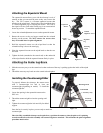
14
B
B
a
a
l
l
a
a
n
n
c
c
i
i
n
n
g
g
T
T
h
h
e
e
M
M
o
o
u
u
n
n
t
t
i
i
n
n
D
D
E
E
C
C
Although the telescope does not track in declination, the telescope should also be balanced in this axis to prevent
any sudden motions when the DEC lock lever is loose. To balance the telescope in DEC:
1. Loosen the R.A. clutch lock lever and rotate the telescope so that it is on one side of the mount (i.e., as
described in the previous section on “Balancing the Mount in R.A.”).
2. Tighten the R.A. lock lever to hold the telescope in place.
3. Loosen the DEC clutch lock lever and rotate the telescope until the tube is parallel to the ground.
4. Release the tube — GRADUALLY — to see which way it rotates around the declination axis. DO
NOT LET GO OF THE TELESCOPE TUBE COMPLETELY!
5. Slightly loosen the knobs that holds the telescope to the mounting platform and slide the telescope
either forward or backward until it remains stationary when the DEC clutch is loose. Do NOT let go of
the telescope tube while the knob on the mounting platform is loose. It may be necessary to rotate the
telescope so that the counterweight bar is pointing down before loosening the mounting platform
screw.
6. Tighten the knobs on the telescope mounting platform to hold the telescope in place.
Like R.A. balance, these are general balance instructions and will reduce undue stress on the mount. When taking
astrophotographs, this balance process should be done for the specific area at which the telescope is pointing.
A
A
d
d
j
j
u
u
s
s
t
t
i
i
n
n
g
g
t
t
h
h
e
e
M
M
o
o
u
u
n
n
t
t
In order for a motor drive to track accurately, the telescope’s axis of rotation must be parallel to the Earth’s axis of
rotation, a process known as polar alignment. Polar alignment is achieved NOT by moving the telescope in R.A. or
DEC, but by adjusting the mount vertically, which is called altitude, and horizontally, which is called azimuth. This
section simply covers the correct movement of the telescope during the polar alignment process. The actual process
of polar alignment, that is making the telescope’s axis of rotation parallel to the Earth’s, is described later in this
manual in the section on “Polar Alignment.”
Adjusting the Mount in Altitude
• To increase the latitude of the polar axis, tighten the rear latitude adjustment screw and loosen the front screw (if
necessary).
• To decrease the latitude of the polar axis, tighten the front (under
the counterweight bar) latitude adjustment screw and loosen the
rear screw (if necessary).
The latitude adjustment on the CG-5 mount has a range from
approximately 30° going up to 60°.
It is best to always make final adjustments in altitude by moving
the mount against gravity (i.e. using the rear latitude adjustment
screw to raise the mount). To do this you should loosen both
latitude adjustment screws and manually push the front of the
mount down as far as it will go. Then tighten the rear adjustment
screw to raise the mount to the desired latitude.
Figure 2-14
Azimuth
Adjustment
Knobs
Rear Latitude
Adjustment
Screw
Front Latitude
Adjustment Screw


















